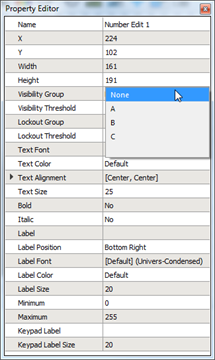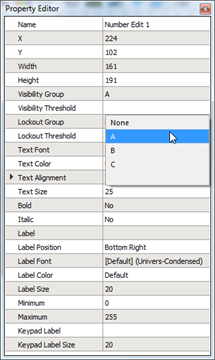Open topic with navigation
Hiding and Disabling Controls
Each control can be member of a "Lockout Group" and "Visibility Group" allowing you to hide or disable controls within a configuration. When a configuration is executed, these groups each have a value between 0 and 100. If the value of a group is greater than or equal to the threshold for a control, that control is disabled (for Lockout Groups) or hidden (for Visibility Groups).
Hiding Controls with Visibility Group
A control can be hidden within a configuration by using the Visibility Group setting. Each control can be member of Visibility Group A, B, C or None; allowing you to hide controls within a configuration.

- Select the control for editing. Reference Selecting Controls.
- Locate the "Visibility Group" property in the Property Editor and select the group to associate the control (A, B, C, or None).
- Locate the "Visibility Threshold" property in the Property Editor and select the threshold value (0-100). 100 is default. This sets the level the selected visibility group must meet or exceed within the Paradigm configuration to hide the control.
If a
parent object (frame, pop-up, etc) is hidden or disabled, its child controls are also hidden or disabled. The "Tabs" control type has lockout and visibility properties which are set per tab, rather than for the control as a whole.
Lockout Controls with Lockout Group
A control can be disabled but still displayed within a configuration by using the Lockout Group. Each control can be a member of Lockout Group A, B, C or None allowing you to disable controls within a configuration.

- Select the control for editing. Selecting Controls
- Locate the "Lockout Group" property in the Property Editor and select the group to associate the control (A, B, C, or None) None is default.
- Locate the "Lockout Threshold" property in the Property Editor and select the threshold value (0-100). 50 is default. This sets the level the selected lockout group must meet or exceed within the Paradigm configuration to enable the control.
If a
parent object (frame, pop-up, etc) is hidden or disabled, its child controls are also hidden or disabled. The "Tabs" control type has lockout and visibility properties which are set per tab, rather than for the control as a whole.
For information on simulating Lockout and Visibility levels, reference Simulating a Configuration.
 Related Topics
Related Topics


